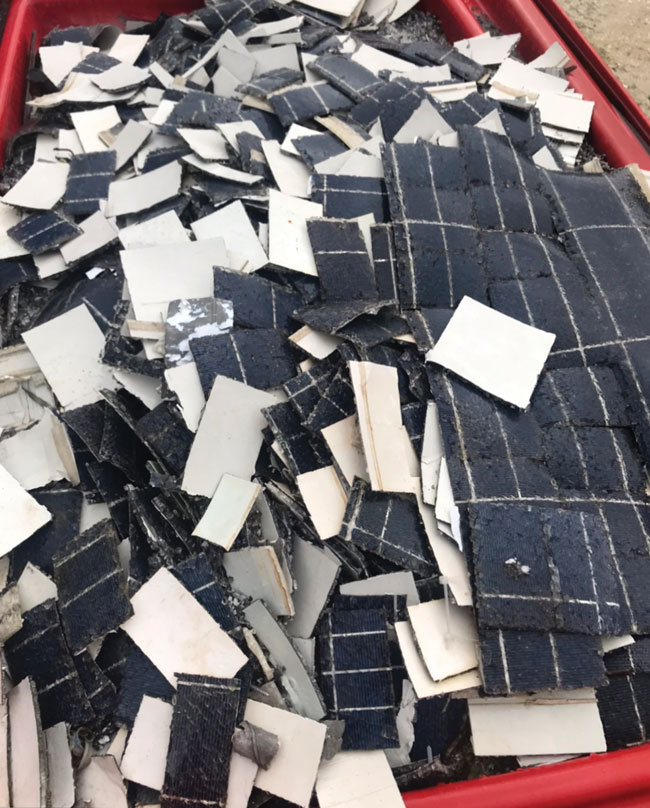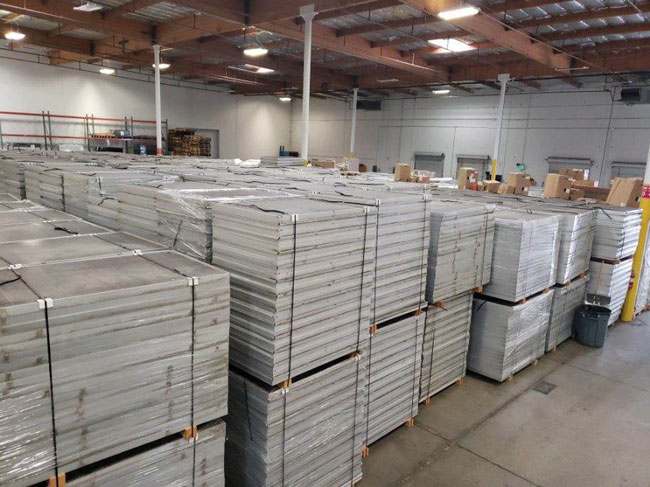By creating a national program for solar recycling now, the U.S. can prepare for large scale decommissioning while also providing the necessary materials to build the green economy.
By Otto Gunderson
Solar energy has seen remarkable growth since the start of the 21st century and is critical in the transition to renewable energy and the creation of a green economy. According to a report done by the Office of Energy Efficiency & Renewable Energy, solar power has grown from 0.34 GW in 2008 to 97.2 million gigawatts currently. Between 1990 and 2020, approximately 400 million PV panels have been installed in the U.S. In 2020 there were between 60 to 70 million PV (Photovoltaic) panels installed. This, combined with the fact that solar costs have been reduced by almost 70 percent since 2004, means that solar has created a strong foothold in the American energy economy.
Disposal Challenges
However, reduced prices and more installations have overshadowed the fact that solar power is not truly green. A report done by the International Renewable Energy Agency (IRENA) titled “End-of-Life Management: Solar Photovoltaic Panels” found that the U.S. had approximately 94,000 tons of PV waste in 2020, which is equivalent to roughly 4.2 million PV panels in 2020. This number will skyrocket to 1.1 million tons in 2030 (approximately 49 million PV panels) and reach 11 million U.S. tons (489 million panels) by 2050. Furthermore, IRENA estimates that these projections are conservative, and the rate of decommissioning will likely be higher.

This becomes even more concerning when the number of panels that are properly recycled are considered. It has been found that roughly 10 percent of decommissioned solar panels are properly disposed of at the end of life. The rest are being either landfilled or sent to developing countries that do not have the same stringent waste laws as the U.S. This is primarily due to a lack of awareness regarding End-of-Life (EoL) processes for PV panels. A report done by the California Product Stewardship Council in 2020 found that 86 percent of the installers that they surveyed did not have a process or policy for dealing with panels at the end of life. Similarly, 97 percent of residents of San Mateo County that were interviewed were not given information on the responsible disposal of solar panels by their installer at the time of installation.
Looking at the EU Solution
However, to find a solution, the U.S. is able to learn from its European counterpart, PV Cycle, to create a successful recycling program. The Waste of Electrical and Electronic Equipment (WEEE) directive amended their program to include solar recycling in 2014. This has resulted in a comprehensive network of solar collection and recycling in the E.U that far surpasses what is currently available in the U.S. With recycling mandated by law, the cost to process solar panels has fallen dramatically. The cost to recycle a panel with PV Cycle is less than one dollar a panel, while in the U.S. it can range from 20 to 30 dollars. European Union regulation requires 85 percent collection and 80 percent recycling of materials found in PV panels. However, PV Cycle has a recovery rate of more than 94 percent, recovering an even greater number of valuable materials for the PV economy.
State Legislations
Rather than approach this problem with national legislation, solar recycling in the U.S. has been left to the discretion of the states. Most notably, Washington State has passed legislation that will require solar manufacturers within the state to create a plan for decommissioning. Once this program is fully implemented, it will apply to both residential projects and large-scale utility projects. This legislation is a form of Extended Producer Responsibility (EPR) and is used to reduce the strain on the system owner. A recent bill proposed in Arizona will also require those who transport panels within the state to create a plan for end of life. This bill would require a $5 processing fee for manufacturers who do not process their own panels at end-of-life. For panels that are not decommissioned properly, there will be a penalty, and the money from these penalties would be used for the creation and maintenance of PV recycling facilities across the state.
North Carolina has likewise attempted to prepare for the scale of solar decommissioning in their state by requiring the North Carolina Department of Environmental Quality (DEQ) to create a report on the decommissioning of PV panels in North Carolina. This report was published on January 1, 2021 and found that North Carolina has 23.3 million installed PV panels, weighing 500,000 tons. The total installed capacity in North Carolina is expected to double in the next five year. Unfortunately, this report recommends an approach of waiting until the larger numbers of decommissioning before creating a comprehensive plan for solar recycling. Similarly, the report did not support an additional fee for manufacturers to be used in the creation of stewardship programs for end-of-life management.

California has recently re-classified its solar waste from toxic waste to universal waste in the hopes that it will make the process of disposing of panels easier. The California Department of Toxic Substance Control hopes that the less stringent guidelines on the shipping and handling of the panels will allow for more panels to be recycled. This re-classification will allow panels to be accumulated for up to one year, rather than the 90-day limit that, allows for less labeling and recording while reducing shipping costs. The DTSC estimates that total statewide benefits of this change will exceed 91 million USD.
The Need for a National Program
The landfilling of millions of solar panels can have lasting negative effects on the U.S waste management system due to the materials that can be commonly found in solar panels. First, the landfilling of solar panels will prevent the U.S. economy from re-using critical materials found in these panels, including copper, zinc, silver and tin. Second, these panels include materials that are considered toxic, including lead, cadmium, telluride and selenium. However, by creating a circular PV economy in the U.S, the materials found in these panels could re-enter the solar market. According to a report done by Recycle PV Solar, which extrapolated data found in the IRENA report on PV EoL, by 2050 the decommissioned panels could have a material recovery value of 2.5 billion, a resale value of 3.2 billion, and a recycling service value of 5.1 billion. These decommissioned panels would also include enough natural resources for the creation of 2
billion new panels. By creating a national program for solar recycling now, the U.S. can prepare for large scale decommissioning while also providing the necessary materials to build the green economy. | WA
Otto Gunderson is a research analyst at Recycle PV Solar, a comprehensive end of life solar recycling company centered in South Lake Tahoe, NV, and a fourth-year student at the University of Virginia. He is excited to enter the clean energy sector after his graduation in spring 2022. He can be reached at [email protected] and can be found on LinkedIn at Otto-Gunderson.
